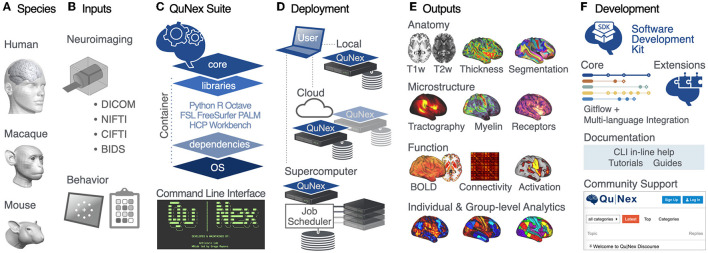Figure 1.
QuNex provides an integrated, versatile, and flexible neuroimaging platform. (A) QuNex supports processing of input data from multiple species, including human, macaque, and mouse. (B) Additionally, data can be onboarded from a variety of popular formats, including neuroimaging data in DICOM, PAR/REC, NIfTI formats, a full BIDS dataset, or behavioral data from task performance or symptom assessments. (C) The QuNex platform is available as a container for ease of distribution, portability, and execution. The QuNex container can be accessed via the command line and contains all the necessary packages, libraries, and dependencies needed for running processing and analytic functions. (D) QuNex is designed to be easily scalable to accommodate a variety of datasets and job sizes. From a user access point (i.e., the user's local machine), QuNex can be deployed locally, on cloud servers, or via job schedulers in supercomputer environments. (E) QuNex outputs multi-modal features at the single subject and group levels. Supported features that can be extracted from individual subjects include structural features from T1w, T2w, and dMRI (such as myelin, cortical thickness, sulcal depth, and curvature) and functional features from BOLD imaging (such as functional connectivity matrices). Additional modalities, e.g., receptor occupancy from PET (positron emission tomography), are also being developed (see Section Discussion). Features can be extracted at the dense, parcel, or network levels. (F) Importantly, QuNex also provides a comprehensive set of tools for community contribution, engagement, and support. A Software Development Kit (SDK) and GitFlow-powered DevOps framework is provided for community-developed extensions. A forum (https://forum.qunex.yale.edu) is available for users to engage with the QuNex developer team to ask questions, report bugs, and/or provide feedback.

